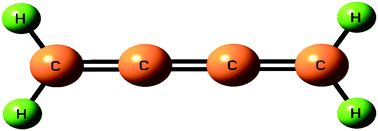A quantum-classical approach to the molecular dynamics of butatriene cation with a realistic model Hamiltonian
Abstract
We are investigating the molecular dynamics of the butatriene

* Corresponding authors
a
Department of Physical Chemistry, Indian Association for the Cultivation of Science, Jadavpur, Kolkata, India
E-mail:
pcsa@mahendra.iacs.res.in
Fax: +91 (0)33 2473 2805
b Department of Chemistry, North-Eastern Hill University, Shillong, India
We are investigating the molecular dynamics of the butatriene

 Please wait while we load your content...
Something went wrong. Try again?
Please wait while we load your content...
Something went wrong. Try again?
S. Sardar, A. K. Paul, P. Mondal, B. Sarkar and S. Adhikari, Phys. Chem. Chem. Phys., 2008, 10, 6388 DOI: 10.1039/B805990J
To request permission to reproduce material from this article, please go to the Copyright Clearance Center request page.
If you are an author contributing to an RSC publication, you do not need to request permission provided correct acknowledgement is given.
If you are the author of this article, you do not need to request permission to reproduce figures and diagrams provided correct acknowledgement is given. If you want to reproduce the whole article in a third-party publication (excluding your thesis/dissertation for which permission is not required) please go to the Copyright Clearance Center request page.
Read more about how to correctly acknowledge RSC content.
 Fetching data from CrossRef.
Fetching data from CrossRef.
This may take some time to load.
Loading related content
